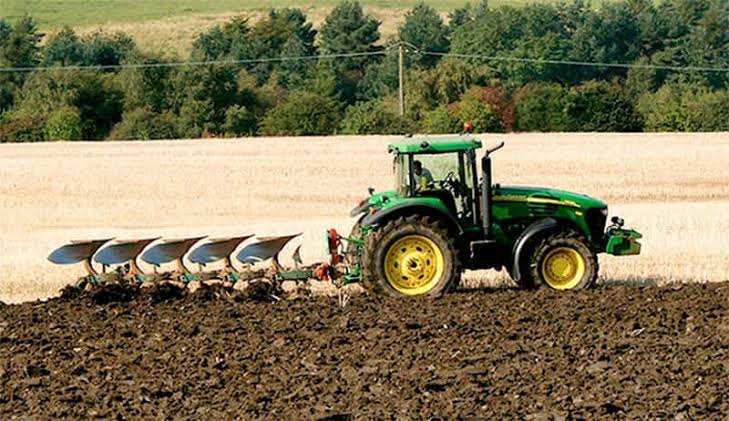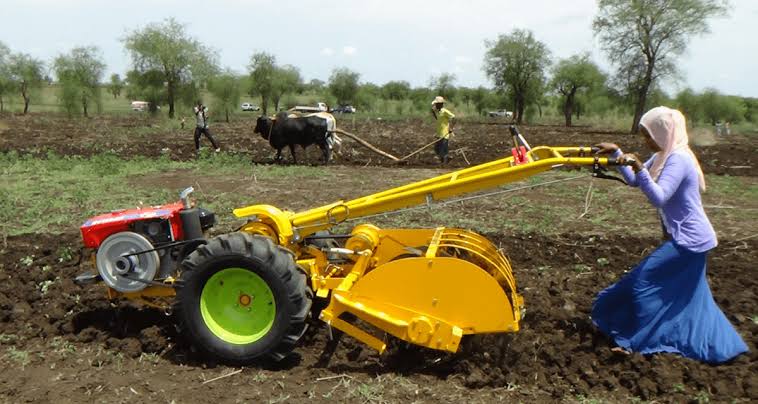Farm equipment refers to the tools and machinery used by farmers to work on their farms. These tools are crucial for various tasks, making farming more efficient and productive. From plowing fields to harvesting crops, farm equipment comes in many shapes and sizes, designed to tackle different aspects of agriculture.
Tractors are one of the most essential farm tools. They’re like strong, powerful horses for modern farmers. Tractors come in different sizes, with big wheels and strong engines. They help plow the land, preparing it for planting seeds. Some tractors also have attachments like plows, cultivators, and seeders, which make the work easier and faster.
Plows are another important farm tool. They dig deep into the soil, turning it over to make it ready for planting. Farmers attach plows to tractors, and together, they can cover a lot of ground in a short time. There are different types of plows, each designed for specific soil types and farming needs.
Harvesters are like magical machines that help gather ripe crops. They come in various types for different crops, like wheat, corn, or fruits. Harvesters collect the crops efficiently, saving a lot of time and effort for farmers. These machines are specially built to cut, gather, and sometimes even separate the edible parts from the rest.
Seeders and planters are tools that precisely place seeds into the soil. They ensure that seeds are sown evenly and at the right depth for optimal growth. These tools help farmers plant their crops efficiently and effectively, increasing the chances of a good harvest.
Farm equipment isn’t just about big machines; it also includes smaller tools like pliers, shovels, and hoes. These tools may seem simple, but they are essential for tasks like weeding, planting small gardens, or fixing minor issues on the farm.
In recent times, technology has made its way into farm equipment, bringing innovations like GPS-guided tractors. These tractors can follow programmed paths, making farming more precise and reducing overlap in tasks like planting and spraying pesticides.
Maintaining farm equipment is crucial for its longevity and proper functioning. Regular cleaning, oiling, and repairs are necessary to ensure that these tools work efficiently during the farming seasons.
Farm equipment plays a vital role in modern agriculture. From tractors to plows, harvesters to seeders, these tools are the backbone of farming, making it easier, faster, and more efficient for farmers around the world. With advancements in technology, farm equipment continues to evolve, promising even better and more sustainable farming practices in the future.
Read Also: How To Grow and Care For Windmill Grass (Chloris texensis)
Importance of Farm Equipments

Farm equipment holds immense importance in agriculture. These tools and machines are the backbone of farming, enabling farmers to perform tasks more efficiently, effectively, and on a larger scale. They play a crucial role in various stages of farming, from preparing the land for cultivation to harvesting the crops.
The significance of farm equipment lies in its ability to:
1. Increase Efficiency: Farm equipment allows farmers to accomplish tasks in less time and with less manual effort. Tractors, plows, and harvesters, among others, automate processes that would otherwise be labor-intensive and time-consuming.
2. Boost Productivity: With the use of appropriate equipment, farmers can cultivate larger areas of land, plant seeds more accurately, and harvest crops efficiently. This increased productivity helps meet the demands of a growing population.
3. Improve Precision: Advanced equipment, such as GPS-guided tractors and precision seeders, ensures precise planting and application of resources like fertilizers and pesticides. This precision minimizes wastage and maximizes crop yield.
4. Enhance Farm Sustainability: Modern farm equipment often incorporates eco-friendly practices. For instance, certain machines reduce soil compaction, conserve water, and minimize the use of chemicals, contributing to sustainable farming practices.
5. Reduce Physical Strain: Farm equipment reduces the physical strain on farmers. It allows them to work comfortably and safely, preventing injuries caused by manual labor.
6. Enable Large-Scale Farming: Equipment facilitates large-scale farming operations that can meet the demands of global food supply. This scalability helps optimize resources and cater to a broader market.
In essence, farm equipment is indispensable in modern agriculture. It not only improves the efficiency and productivity of farming but also plays a pivotal role in ensuring food security for the growing population.
Uses of Farm Equipments
Farm equipment serves a multitude of purposes across various stages of agriculture:
1. Land Preparation: Tools like plows and harrows are used to break and till the soil, preparing it for planting. They help loosen the soil, remove weeds, and create an ideal seedbed for sowing.
2. Planting and Seeding: Seeders and planters accurately place seeds in the soil at optimal depths and spacing. This ensures uniformity in planting, promoting healthy crop growth.
3. Crop Maintenance: Equipment such as sprayers and cultivators help in maintaining crops. Sprayers are used to apply fertilizers, pesticides, and herbicides to control pests and weeds. Cultivators aid in weeding and aerating the soil around the plants.
4. Irrigation: Some farm equipment, like irrigation systems, helps in providing water to crops. These systems ensure that crops receive adequate water, especially in areas with irregular rainfall patterns.
5. Harvesting: Harvesters are specialized machines used to gather ripe crops efficiently. They cut, collect, and sometimes process the crops, reducing the time and labor required for harvesting.
6. Transportation: Equipment like trailers and wagons are used to transport harvested crops from the field to storage or processing facilities. They help in efficiently moving bulk quantities of produce.
7. Livestock Care: Farm equipment is also used in livestock farming. Machinery such as feeding systems, milking machines, and shearing tools streamline tasks related to caring for animals.
8. Maintenance and Repair: Tools like wrenches, grease guns, and diagnostic equipment are used to maintain, repair, and troubleshoot issues with farm machinery. Regular maintenance ensures that the equipment operates efficiently.
9. Waste Management: Equipment like composters and shredders aid in managing farm waste. They help in recycling organic matter, creating compost for soil enrichment, and minimizing environmental impact.
Overall, farm equipment serves diverse functions, contributing significantly to the efficiency, productivity, and sustainability of agriculture. These tools streamline various farming processes, enabling farmers to manage their land, crops, and livestock more effectively.
Read Also: How To Grow and Care For Thatching Grass (Hyparrhenia spp)
Types of Farm Equipments

Farm equipment encompasses various types designed for specific farming tasks:
1. Tractors: These versatile machines come in different sizes and configurations. They are used for plowing, tilling, planting, and hauling. Tractors often have attachments for specific tasks, such as plows, cultivators, and loaders.
2. Plows: Available in different designs like moldboard, disk, or chisel plows, they’re used to turn and break the soil, preparing it for planting by burying weeds and residues.
3. Harvesters: These machines are designed for efficient harvesting of specific crops, like combine harvesters for grains, cotton pickers for cotton, and fruit harvesters for fruits. They cut, gather, and sometimes process the crops.
4. Seeders and Planters: These tools ensure accurate seeding and planting of crops. They come in various types, such as broadcast seeders for spreading seeds evenly and precision planters for placing seeds at specific depths and spacing.
5. Sprayers: Used for applying fertilizers, herbicides, and pesticides to crops. Sprayers come in different forms, including handheld, backpack, and tractor-mounted models.
6. Cultivators: These machines are used to weed between rows of crops and aerate the soil, promoting better growth by removing unwanted plants and breaking up compacted soil.
7. Irrigation Systems: Equipment like sprinklers, drip systems, and pivots are used to provide controlled water supply to crops, ensuring they receive adequate moisture for healthy growth.
8. Livestock Equipment: This includes tools for animal care, such as feeding systems, milking machines, shearing equipment, and handling facilities designed for managing livestock efficiently.
9. Storage and Transport: Equipment like trailers, wagons, and silos aid in storing and transporting harvested crops and materials around the farm.
10. Precision Agriculture Tools: Modern advancements include GPS-guided tractors, drones, and sensors that enable precise farming practices, optimizing resource usage and increasing yields.
These types of farm equipment are tailored to specific agricultural needs, allowing farmers to efficiently manage their land, crops, and livestock.
How Maintain Farm Equipments

Maintaining farm equipment is essential for its longevity and efficient performance. Here’s a simple guide on maintaining these machines:
1. Regular Cleaning: After each use, clean the equipment thoroughly to remove dirt, debris, and residue. Use water, mild detergent, and brushes to clean the exteriors and hard-to-reach areas.
2. Inspect Before Use: Before starting any task, inspect the equipment for any visible damage, loose parts, or leaks. Check the tires, belts, hoses, and connections for wear and tear.
3. Follow Maintenance Schedules: Adhere to manufacturer-recommended maintenance schedules outlined in the equipment’s manual. This includes oil changes, filter replacements, and other routine checks at specified intervals.
4. Lubrication: Keep moving parts well-lubricated as per the manufacturer’s recommendations. Lubricate hinges, bearings, chains, and other moving components to reduce friction and wear.
5. Store Properly: When not in use, store the equipment in a dry, covered area to protect it from weather elements. If possible, store them indoors or under proper shelter.
6. Replace Worn Parts: Inspect and replace worn-out or damaged parts promptly. This includes belts, blades, filters, and any other components that are critical for the equipment’s functioning.
7. Calibration and Adjustment: Calibrate and adjust the equipment, especially precision tools, to ensure accurate performance. Follow calibration guidelines provided by the manufacturer.
8. Professional Servicing: For complex maintenance tasks or repairs, seek assistance from certified technicians or service professionals. They can handle intricate repairs and ensure proper functioning of the equipment.
9. Training and Education: Train operators and farm workers on proper equipment usage and maintenance practices. Educate them about safety protocols and basic troubleshooting.
10. Keep Records: Maintain records of maintenance activities, repairs, and servicing. This helps in tracking the equipment’s performance history and aids in scheduling future maintenance tasks.
By regularly cleaning, inspecting, and following maintenance schedules, farmers can extend the lifespan of their farm equipment and ensure that it operates efficiently during critical farming seasons.
Read Also: Internal and External Sources of Finance in Business
